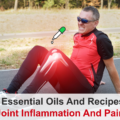Young or old, man or woman, human or animal, everybody has dealt with this condition at some point. Why even plants suffer from this little problem! Yes, I am talking about cuts. They say that a paper cut is a tree’s last revenge. If that is true, then a kitchen cut is the knife’s first display of strength. But, cuts hardly appear only because of knives and paper edges.
Hello All, I am Olivia and I am glad to have you folks back with me on this health and wellness-focused journey through the world of essential oils. We usually tend to discuss pressing health concerns. So today, I thought I’d handle a common issue; one that spares nobody.
Get just an inch too close to a sharp edge or let your attention waiver just for a second while you are chopping those veggies and you are bound to end up with a cut. Whether the laceration is deep or superficial and whether it’s being treated at home or in the ER, the first order of business is always to staunch the bleeding.
But, how do you get the blasted bleeding to stop? And when the leak of the life force from your body is stemmed, how do you handle the pain and inflammation? Finally, what about the risk of infection and scarring?
Well, I am going to handle all of these questions in this article. So, get yourself a cup of soothing chamomile tea, sit back and enjoy the flow of information because what you have here is “Olivia’s Ultimate Guide To Using Essential Oils For Healing Cuts”.
First, Let’s Talk About The Physiology Of Cuts!
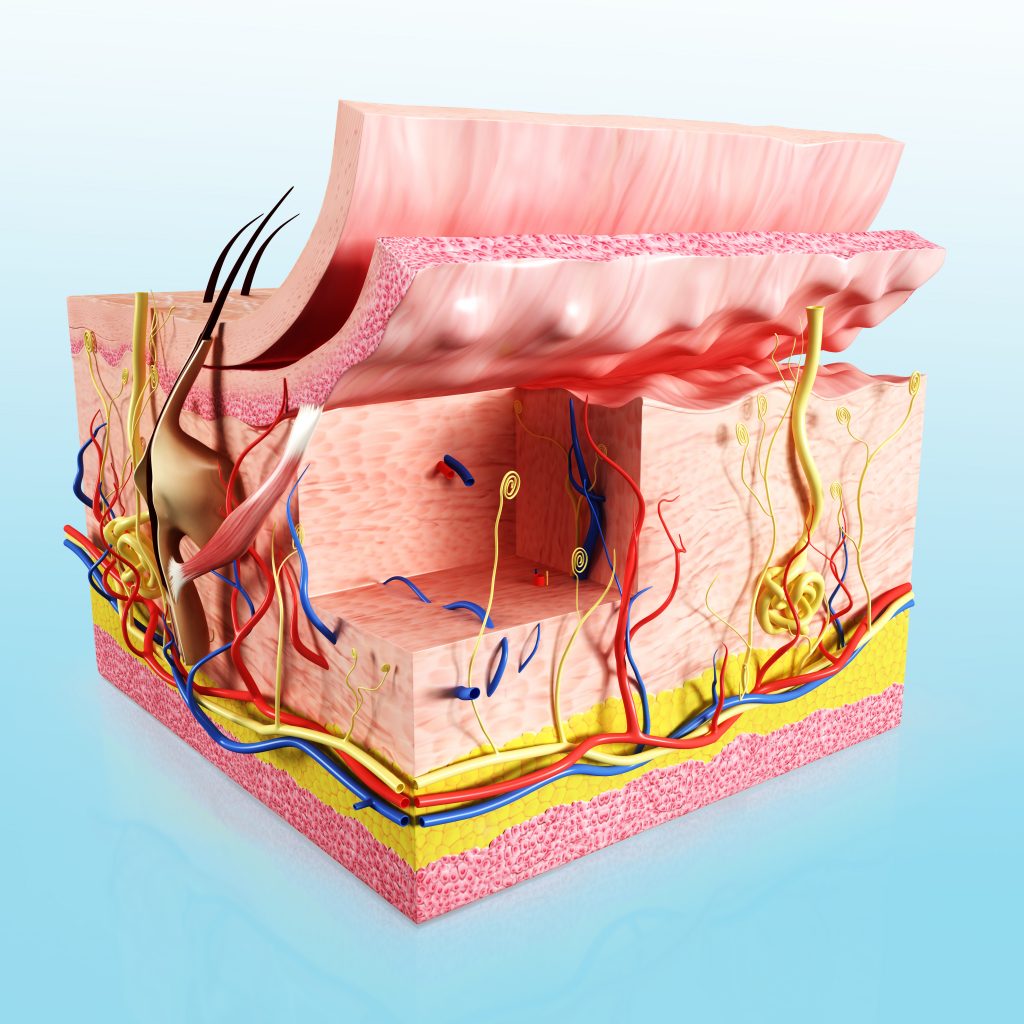
The name says it all; a cut is when the continuous sheet/layer of dermal cells breaks or opens, exposing the nerves and the structures underneath. These lacerations can be superficial or deep. They can be jagged or smooth, depending on what caused the cut.
Most superficial cuts offer little cause for concern because it is just the epidermis and the dermis that are involved. On the other hand, a deep cut can impact major blood vessels that may have been severed as well as the muscles, ligaments, nerves and even the bone.
The first indication of cut is the sharp pain that makes you reflexively pull the affected part away. And, that’s when you notice the bleeding. Depending on just how deep the skin damage runs, you may bleed a lot or may just see a thin line of blood appear on the surface of the skin.
Within a few seconds, the sharp pain turns to a dull, burning pain that persists till the wound starts healing, and sometimes even after, if the deeper tissues sustain significant damage.
That said, if the wound is not too deep and if you are an otherwise healthy person, who is not on blood thinning medication, you won’t have much of a problem stemming the blood flow. However, the likelihood of infection is another story all together; one that has to be considered regardless of the wound size and your health.
What Are The Problems With An Open Wound!
Typically, cuts that result from an encounter with a sharp object like a kitchen knife or a razor blade carry a lower risk of infection, unless you go out of your way to introduce dirt into the wound. That said, lacerations caused by animal teeth, broken glass, thorns, cuts that are on the feet and over all wounds that get dirty do have a higher risk of getting infected. An infection will bring along some tell-tale signs, which include:
- Increase in fluid drainage from the wound.
- Discharge of yellow, green or brown pus.
- Discharge with foul odor.
- Red streaks around the wound.
- Swollen lymph nodes (in the groin or armpit).
- Fever.
- A wound that just does not seem to heal.
Apart from a simple bacterial infection, an open wound can also lead to other complications such as:
- Lockjaw, which is a hallmark of a tetanus infection.
- Gangrene, which is a very serious and potentially life threatening bacterial infection that can not only lead to tissue loss but also sepsis.
- Cellulitis, which is an infection that spread to the deeper tissue in the body that may/may not be in contact with the wound.
Fortunately, most of these risks can be mitigated by prompt and regular wound care. I will list a few do’s and don’ts but before that let us talk about when you need to seek medical attention for a cut.
You know you need to see a doctor for an open wound if:
- There is heavy blood loss and you cannot stanch the bleeding even with the application of direct pressure on the wound for 8-10 minutes.
- You have a problem with blood clotting.
- You are using blood thinning medication (warfarin) or slow release aspirin.
- You cannot move the injured part and this has nothing to do with the pain.
- There are more than 1-2 deep wounds.
- The cut is more than one quarter of an inch in length.
- The wound is deep enough to expose underlying muscles, fatty tissue, bones.
- The person is otherwise seriously injured (typically has been in an accident).
- The wound was sustained in an assault or due to an animal bite.
- The cut/wound was caused by a rusty object.
- The laceration has foreign objects stuck to it or dirt in it.
- You experience throbbing, pain and swelling at the wound site.
- The wound site is warm to touch with significant redness.
- There are any signs of infection (read above).
- If the wound is on the face, the neck or in any area with thin muscle and skin coverage like the wrist.
- You have not been inoculated against tetanus in the last decade.
- The bleeding lasts for more than 20 minutes.
- You suffer from diabetes.
How Do You Tend To A Cut And Open Wounds In General
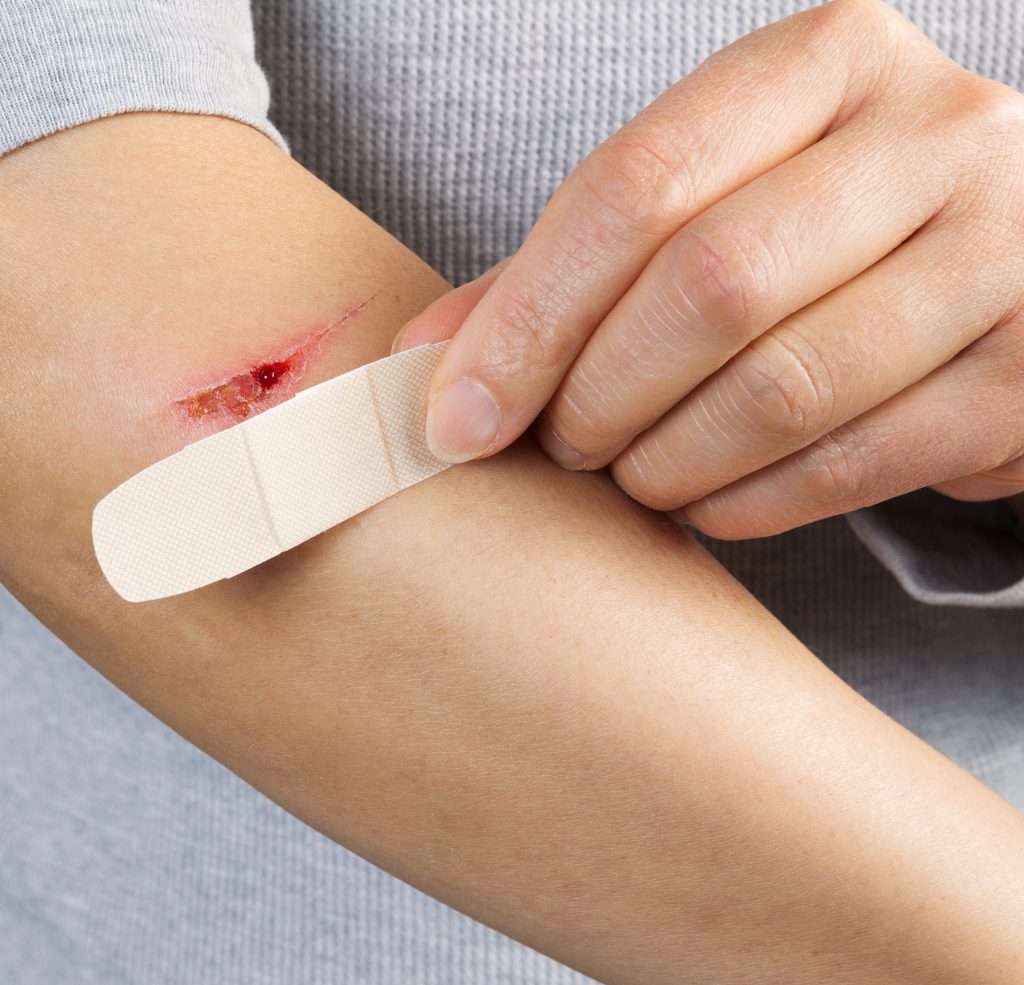
The Do’s
- Always wash your hands before you handle the wounded area, even if you are going to use an antiseptic formulation on the wound.
- Wash the cut/open wound thoroughly using water at room temperature or colder and mild soap.
- To stanch the bleeding, use direct pressure on the wound for 4-6 minutes.
- Clean the wound using an antiseptic lotion/spray/product.
- Follow with an antiseptic ointment and preferably a breathable bandage that will not stick to the skin/wound.
- Look for debris or foreign matter on top of the skin/wound.
- Remove with tweezers that have been cleaned with an antiseptic lotion/spray.
- If you have a puncture wound and a part of the object that caused it is missing, seek medical help.
The Don’ts
- Don’t use a needle or any other object to poke inside the wound or around it to find/extract foreign matter/debris.
- Wipe the wound gently, don’t scrub it raw in an attempt to dislodge the debris.
- Wound licking is a primal instinct, almost a reflex of sorts, but it’s gross and it can cause infections depending on your levels of dental hygiene. So, don’t do it.
- In fact, don’t breathe on the wound either.
- If an object is stuck deep in the wound, don’t try to dislodge it. Let the doctor handle the situation.
- Don’t try to clean the wound after you have stemmed the bleeding.
- Do not pick at scabs.
- Do not expose the wounded part directly to sunlight.
How Will A Doctor Treat Your Cuts And Open Wounds?
In most cases, you will be sent home with a shiny new bandage and a recommendation for OTC painkillers. The doctor will tell you to avoid aspirin because the drug can prolong bleeding. You will also be given a topical antiseptic ointment. Since most of us have these things at home, nobody actually bothers to see a doctor for minor lacerations.
But if the cut is bigger than ½ inch and deep enough to cause significant bleeding, then you will need sutures to close it. If the wound is big and infected, the infected parts may have to be surgically removed. This is how the process is handled:
- At first, the good folks in the ER/ at the doctor’s clinic will stop the bleeding by using a tourniquet, direct pressure or even a blood pressure cuff, depending on the area of the wound.
- Nobody is expecting you to sit through the stitching session without an anesthetic, but they won’t put you under, unless you have suffered a stab wound or serious trauma in an accident and have damaged bones and internal organs that also have to be sutured.
- For other types of cuts, local anesthesia is either administered at the site of the wound or at the regional nerve point. For instance, for a deep cut on the finger tip, you may be given a shot at the base of the finger. This is called a nerve block.
- Once they make sure you won’t feel a thing, they start by cleaning the wound. This involves the removal of crusted blood, debris, foreign matter, etc. using tweezers, hydrogen peroxide and antiseptic solutions.
- To ensure that they get to even those contaminants that are lodged deep inside the cut, doctors also use saline irrigation. This is basically another name for squirting a lot of saline water under high pressure to remove all the debris and even bacterial contamination from the wound.
- Then, the wound will be closed using tissue glue or special surgical adhesive if the cut is small (about an inch and not too deep) or by using stitches if the deeper structures have been damaged.
- A bandage will then be chosen depending on the type of injury and the level of protection needed. You may be called for a dressing change after a day or two or after 5-7 days, depending on your risk of infection and difficulty in changing the bandage at home.
- Usually, stitches on the face are removed within 4-7 days while sutures in other parts are left for 14 days or more.
Will Essential Oils Magically Heal All Boo Boos?
Hell No! If your injuries are grave enough to need suturing, essential oils will not be able to stem the blood flow. So, if you have a cut that is big and deep, don’t wait to faint of blood loss because you relied too much on home treatments and essential oil recipes. Call 911 at once or rush to the nearest hospital if you can.
After a doctor has handled the cut as he/she deems appropriate then comes the part where you put the antibacterial, antiseptic, analgesic, healing and anti-inflammatory properties of essential oils to use. Regardless of the size of the cut, its depth, position on the body and how it was caused, there will be pain and inflammation because these are part of your body’s response to the injury and the normal physiology of healing.
Now, this is where essential oils come to your rescue. They not only bring the pain and the inflammation in control but also boost the pace of healing and regulate the formation of scar tissue. So, if you are worrying about the cut leaving a sorry reminder of its occurrence on your body, these volatile extracts can show scars the way out. That said, let us start talking about essential oils that can help you to heal.
The 13 Best Essential Oils For Cuts
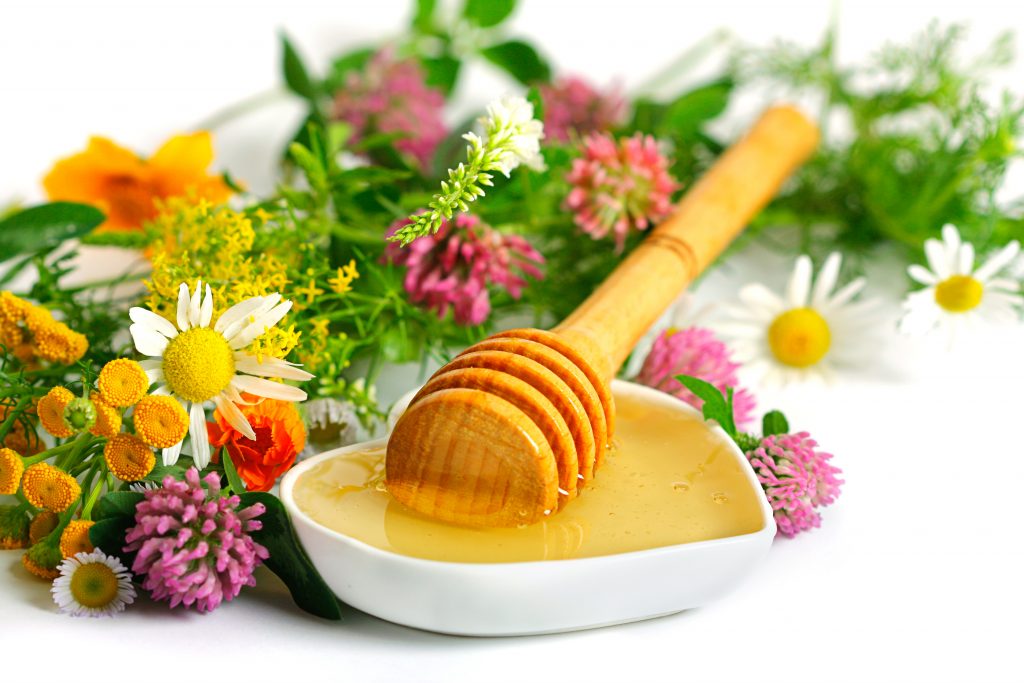
For their healing and analgesic properties, we will use:
- helichrysum,
- chamomile,
- geranium, and
- lavender.
For their fabulous ability to eliminate infection causing bacteria, we will use:
- rosemary,
- oregano,
- thyme, and
- tea tree.
For their astringent properties, we will use:
- lemongrass,
- lemon, and
- sweet orange.
For their ability to stanch the bleeding, we will use:
- myrrh, and
- frankincense.
Top 5 Essential Oil Recipes For Cuts
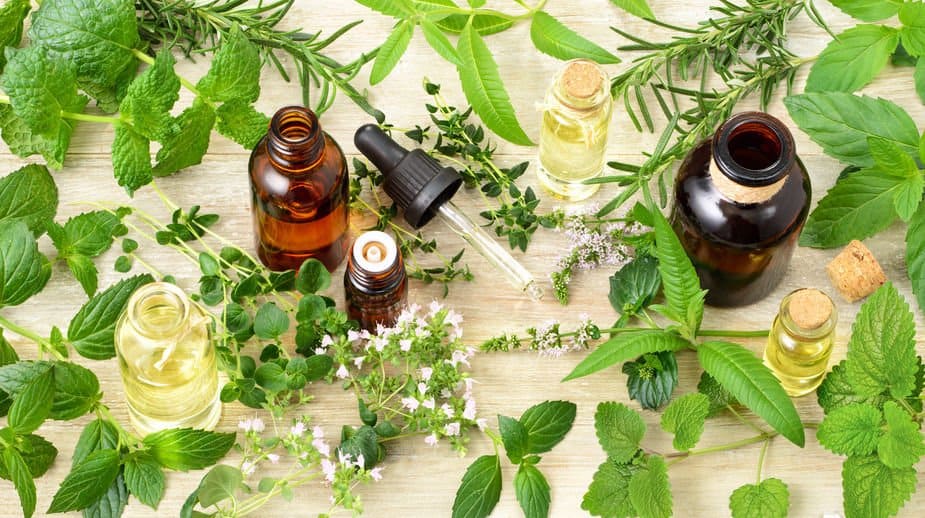
1. Antiseptic wash/spray for cuts and wounds
Ingredients:
- 1 cup distilled water
- 2 tbsp grapefruit seed extract
- 1 tsp olive oil
- 3 drops Tea tree
- 4 drops Oregano
- 4 drops Lemongrass
Method:
Mix the essential oils with the olive oil and set aside. Pour the distilled water in a spray bottle and add the lipid mixture on top. Close the spritzer lid of the bottle and give it a good shake. Then, spray directly on the wound. Spritz a good 3-4 times and then dab with clean tissue paper, or wipe the wound and the surrounding area with cotton wool soaked in the antiseptic fluid.
2. Stem the blood blend!
Ingredients:
- 2 tsp turmeric powder
- 1 tsp indian lilac or neem powder
- 1 tsp comfrey root powder
- 3 drops Myrrh
- 4 drops Geranium
Method:
Premix this blend and if possible store it in the refrigerator. After applying 1-2 minutes of direct pressure to the cut, use this dry blend to stop the bleeding completely and to quickly form a scab.
To make, mix the dry powders together in a glass bowl. Blend the essential oils separately in a smaller glass bowl. Add the lipid blend to the powders one drop at a time, and continue mixing vigorously as you do so to prevent the formation of lumps. Store in a small, dark colored glass jar. Once prepared, you can use the blend for up to 6 months, to treat any type of wound or infectious skin problem.
After you slow down the bleeding by applying direct pressure, use a small spoon to put the powders directly on the bleeding cut/gash. The dry blend will mix with the blood flow and greatly increase the pace of clotting. The scab will be bigger, but the next recipe and the next cleansing session will take care of that.
3. Quick healing salve for cuts
Ingredients:
- 2 tbsp manuka honey
- 2 drops each of lavender, rosemary and roman chamomile essential oils
Method:
Mix all the ingredients together and store under the same conditions as you would a pure essential oil blend. Remember to always use dark glass containers. Once the wound has been sealed with the dry mix above.
Reach for this salve and apply it on the wound site with a Q tip. Discard the Q tip after use. You will only need a small dollop for a finger/hand cut. Apply a thin layer of the essential oil infused honey on the cut and then cover with breathable bandage.
Remove after 4-5 hours and wash the wound under running water. If the dry mix leaves you with a big clot/scab, this process will take it out without hurting the wound. In fact, the honey and the essential oils will jumpstart the healing process.
4. Healing and pain relieving ointment
Ingredients:
- 2 tbsp shea butter
- 2 tbsp. calendula infused carrier oil
- 5 drops each of helichrysum, geranium and blue yarrow
- 3 drops each of thyme and peppermint
- 2 drops eucalyptus
Method:
Remove the shea butter and the calendula infused oil into a double boiler. Heat till the butter melts. Take it off the flame and whisk it vigorously to combine the oil with the butter. At this point the lipid mixture will already have cooled a bit. Add the essential oils to the blend and whisk again before pouring the mixture into a dark colored glass jar.
Allow it to cool completely and then put the lid back on and place the mixture in the refrigerator. To use apply on the wound with a q tip as you would any antiseptic ointment. Use it 1-2 times a day till the wound heals completely.
5. Scars don’t come my way blend
Ingredients:
- 60 ml sweet almond and grapeseed/rosehipseed oil
- 8 drops lemon essential oil (steam distilled) or sweet orange (cold pressed)
- 5 drops each of chamomile, frankincense, geranium, lavender essential oil
- 3 drops each of carrot seed and rosemary essential oil
Method:
Once the pain is almost gone and the wound seems to be on its way to healing, start using this blend of oils to keep the spot moisturized, boost tissue generation and prevent or at least lower the risk of scars. Continue using even after the wound has completely healed and the scab has fallen off. The idea is to use this blend to deal with the hyperpigmentation and the raised scar tissue that you are bound to see after recovery.
To prepare, mix all the oils and store in a dark colored glass bottle. To use, dip a Q tip in the oils and apply on top of the cut/wound as well as on the surrounding areas. Till the scab covers the wound, massage gently on the surrounding areas. Once the scab falls off, also work on the wound site using gentle, circular strokes.
Home Treatment For Cuts, Scratches And Other Open Wounds

1. Aloe vera gel can save the day
Refrigerated aloe vera gel applied directly on the wound will not just soothe inflammation but will also create a protective barrier that will keep infection causing germs away.
2. Have some immunity boosting tea
Ginger tea with a tsp of manuka honey added to it will soothe the stress of sustaining the injury, plus, it will increase your body’s ability to heal itself.
3. Go for the golden milk shake
You will need a 4-5 almonds and 3-4 walnuts (only 4-5 walnuts if using almond milk), a cup of milk, ½ tsp turmeric powder, honey to taste. Put the ingredients in the blender and process at high speed for about a minute. Pour the smoothie into a glass and enjoy once a day.
4. Load up on your nutrients
Vitamin C and Zinc are two nutrients that will super charge your healing mechanism. Plus, the blood loss also calls for supplementation with iron. If you are using a high quality daily multi vitamin and mineral pill, it should have you covered. But, if you are not a supplement person, do take a multi vitamin at least while you heal.
5. The right foods can get you up and about in record time
What you put in your tummy will, at the end of the day, determine just how good you feel and how fast you heal. So, up your intake of lean proteins, nuts, legumes, green leafy vegetables and fresh fruits.
On the other hand, stay away from inflammation causing/increasing foods like sugar, hydrogenated fats, products that contain artificial flavoring, color and preservatives, and of course, booze.
On A Closing Note!
Regardless of how cautious a person you are, some scrapes and cuts are bound to come your way. The good news is that if the cut was not sustained in a major accident, your body can heal itself with just a bit of help from you, and without the need for pain killers and antibiotics.
Don’t send out modern medicines to do a job that is clearly meant for Mother Nature. With the recipes discussed above, you can tackle all the problems that you are likely to encounter with open wounds. The important thing is to not ignore a wound, however small or insignificant it is.
Remember every time your skin breaks, it essentially creates a pathway for outside matter, read bacteria and virus, to get into your system, and once they get in, it can get hard to get them out. So, use your essential oil arsenal to shut these critters out of your body. And on that note, here is wishing you all a life without cuts and pain and full of healing and happiness!


